This Compound Interest – CA Foundation Maths Study Material is designed strictly as per the latest syllabus and exam pattern.
Compound Interest – CA Foundation Maths Study Material
Compound Interest:
Compound interest (or compounding interest) is interest calculated on the initial principal and which also includes all of the accumulated interest of previous periods of a deposit or loan, the computed interest is called Compound Interest.
Conversion Period:
The period at the end of which the interest is computed is called Conversion period.
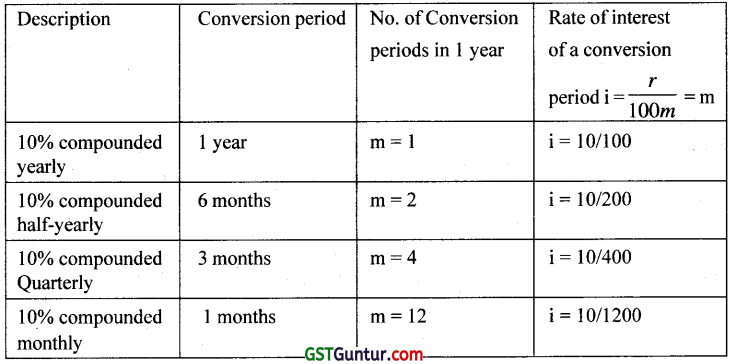
Formula: Compound Amount = A = P = P(1 + \(\frac{r}{100 m}\))m
= P(1 + i)m
Where i = \(\frac{r}{100 m}\) & n = mt
100m
Compound Interest = p[(1 + i)m – 1]
Type – I (To find Amount & Compound Interest) Working Rule:-
- If rate of interest compounded yearly then divide r by 100 i.e i = \(\frac{r}{100}\)
- If rate of interest compounded \(\frac{1}{2}\) yearly Then divide r by 200 i.e = \(\frac{r}{200}\)
- If rate of interest compounded \(\frac{1}{4}\) yearly then i = \(\frac{r}{400}\)
- If rate of interest compounded monthly then i = \(\frac{r}{1200}\) and so on.
Calculator Tricks:
- Step-I Type r then push + button then type 100 if r is yrly.; 200 if r is half yearly and so on.
- Step-II Press + 1.
- Step-Ill Press x button
- Step-IV Continue pressing “=” button (n – 1 = power – 1) times.
- Step -V Press × button then type principal value then push = button. We will get the result of amount on calculator screen.
- Step -VI Press – button then type principal value, we will get the value of compound Interest on the screen.
![]()
Ex. 1
₹ 2000 is invested at annual rate of interest of 10%. What is the amount after 2 years if compounding is done.
(a) Annually
(b) Semi-annually
(c) Quarterly
(d) Monthly.
Answer:
(a) Given that P = ₹ 2000; r = 10% yrly.; t = 2 years.
i = \(\frac{r}{100}=\frac{10}{100}\) = 1
n = mt = 1 × 2 = 2
[∵ m = No. of conversion periods in a year = 1]
∴ A = P(1 + i)n
= 2000(1 + \(\frac{10}{100}\))1×2 = 2000(1.10)2
= ₹ 2420.
Calculator Trick
Work As
Type 10 ÷ 100 + 1 × button then press = button (2 – 1 = 1) time then press × button type 2000 then press = button. (This is the required result).
(b) i = \(\frac{10}{200}\); m = 2
n = mt = 2 × 2 = 4
A = 2000\(\left[1+\frac{10}{200}\right]^{2 \times 2}\) = 2000(1+ 0.05)4
= 2000 × 1.21550625 = Rs. 2431.0125
= Rs. 2431.
Calculator Trick
Type 10 ÷ 200 then + 1 thenx button then press = button (4 – 1 = 3) times then type × 2000 = button (we get the required result)
[This Trick will take minimum 5 seconds and saves lots of time]
(c) n = mt = 4 × 2 = 8
∴ A = P(1 + i)n = 2000(1 + \(\frac{10}{400}\))4×2
= 2000 × [1 + 0.025]8 = 2000 × 1.2184
= ₹ 2436.81
Calculator Trick
Type 10 ÷ 400 + 1 × Then press = button (8 – 1 = 7) times then × 2000 = button (we get the result)
(d) i = \(\frac{10}{1200}\), m = 12;n = mt = 12 × 2 = 24
Calculator Trick:
Type 10 ÷ 1200 + 1 × button then press = button (24 – 1 = 23) times then press × 2000 = button (we get the result) = ₹ 2440.78.
Ex. 2
Determine the compound amount and compound interest on ₹ 1000 at 6% compounded semi-annually for 6 years. Given that (1 + i)n = 1.42576 for i = 3% and n = 12.
(a) ₹ 1425.76; ₹ 425.76
(b) ₹ 1420.76 ; ₹ 420.76
(c) ₹ 1525.76 ; ₹ 525.76
(d) None
Answer:
(a) is correct.
Given that P = ₹ 1000; t = 6 years
r = 6 % compounded half -yearly
∴ m = 2 ; i = \(\frac{6}{200}\) = 0.03
n = mt = 2 × 6 = 12
∴ A = 1000(1 + 0.03)12 = 1000 × 1.42576
= ₹ 1425.76
C.I = A-P = 1425.76 – 1000 = ₹ 425.76
[Note:- If (1 + i)n value is given in the question then use that given value]
Calculator Trick [If values not given]
Type 6 ÷ 200 + 1 × Then press = button (12 – 1 = 11) time then × 1000 = button; we will get the required result = 71425.76 = Amount. Press -1000 = button we will get compound interest value.
Effective Rate of Interest:
Type – II
The equivalent annual rate of interest compounded annually if interest is compounded more than once in a year is called EFFECTIVE RATE of INTEREST. It is denoted by E or re.
Formula:
re = E = [(1 + \(\frac{r}{100 m}\))n – 1] × 100 = (1 + i)m – 1
where r = Nominal rate of interest, m = No. of conversion periods in a year.
Calculator Trick
Type r ÷ 100m then push × button then push = button (m – 1) times then – 1 then push × 100 = we get re in %.
Ex- Find effective rate of interest of the nominal rate of interest 6% compounded quarterly.
Answer:
r = 6% compounded quarterly,
m = 4
∴ re = [(1 + \(\frac{6}{400}\))n – 1] × 100 = 6.136355062 % = 6.14%
Calculator Trick
Type 6 ÷ 400 + 1 × button then press = button (4 – 1 = 3) times then – 1 then × 100 then press = button we get the required result.
![]()
Ex- Find effective rate of interest of 12% compounded monthly.
Answer:
r = 12% compounded monthly, m = 12
∴ re = [(1 + \(\frac{12}{1200}\))12 – 1] × 100% = 13.6825%
Type 12 ÷ 1200+ 1 × button then press=button 11 times then – 1 then × 100 = button.
[we get the required result ]
Type-III (To find Present Value)
∵ A = P(1 + i)n
or P = \(\frac{A}{(1+i)^n}\)
or P = A(1 + i)-n
Calculator Trick
Step-I Type i = r ÷ 100 m + 1
Step-II Press ÷ button
Step-III Press = buttons n times i.e. (power times)
Step-IV Press × button then type A value then press = button (we get the required result)
Ex- A certain sum invested at 4% per annum compounded semi annually amounts to ₹ 78030 at the end of one year. Find the sum.
(a) ₹ 75000
(b) ₹ 70,000
(c) ₹ 72000
(d) None
Answer:
option (a) is correct
A = ₹ 78030; r = 4% compounded semi – annually
m = 2, t = 1 yr.
n = mt = 2 × 1 = 2
= 74999.999….= ₹ 75000
Calculator Trick
Type 4 ÷ 200 + 1 then press ÷ button then press = button (power=2) times then press × button then type A value = 78030 then press = button we get the required result.
Previous Year Exam Questions
Question 1.
The difference between the simple and compound interest on a certain sum for 3 year at 5% p.a. is 228.75. The compound interest on the sum for 2 years at 5% p.a. is: [1 Mark, Nov. 2006]
(a) 3,175
(b) 3,075
(c) 3,275
(d) 2,975
Answer:
Tricks
P = \(\frac{\text { Difference } \times(100)^3}{r^2(300+r)}\) [For 3 years only]
= \(\frac{228.75 \times(100)^3}{5 \times 5(300+5)}\) = ₹ 30,000
A = 30000 + 5 % + 5% buttons = ₹ 33075
∴ C.I = A – P = ₹ 33075 – 30000
= ₹ 3,075
(b) is Correct
Question 2.
In what time will ₹ 3,90,625 amount to ₹ 4,56,976 at 8% per annum, when the interest is compounded semi-annually ? [Given: (1.04) = 1.16986] [1 Mark, Feb. 2007]
(a) 2 years
(b) 4 years
(c) 5 years
(d) 1 years
Answer:
(a)
A = P(1 + \(\frac{r}{100m}\))mt
\(\frac{4,56,976}{3,90,625}=\left(1+\frac{8}{200}\right)^{2 t}\)
or 1.16985856 = (1.04)2t
or 1.16966 = (1.04)2t
or (1.04)4 = (1.04)2t
∴ 2t = 4 ∴ t = 2 years
(a) is correct
![]()
Question 3.
How long will ₹ 12,000 take to amount to ₹ 14,000 at 5% p.a. converted quarterly? [Given: (1.0125)124 = 1.1666] [1 Mark, May 2007]
(a) 3 years
(b) 3.1 years
(c) 13.5 years
(d) 12.4 years.
Answer:
(b) \(\frac{A}{p}=\left(1+\frac{5}{400}\right)^{4 t}\)
or \(\frac{14000}{12000}\) = (1.0125)4t
or 1.16666…………… (1.0125)4t
or (1.0125)12.4 = (1.0125)4t
[Note Always use values given in question]
or 4t= 12.4 ∴ t = 3.1yrs.
∴ (b) is correct
Tricks See Type – VII. (Quicker BMLRS)
Question 4.
If ₹ 1,000 be invested at interest rate of 5% and the interest be added to the principal every 10 years, then the number of years in which it will amount to ₹ 2,000 is : [1 Mark, Aug. 2007]
(a) 16\(\frac{2}{3}\)years
(b) \(\frac{1}{10}\) years
(c) 16 years
(d) 6\(\frac{2}{3}\) years
Answer:

Tricks See Type VI
Question 5.
The annual birth and death rates per 1000 are 39.4 and 19.4 respectively. The number of years in which the population will be doubled assuming there is no immigration or emigration is : [1 Mark, Aug. 2007]
(a) 35 years
(b) 30 years
(c) 25 years
(d) None of these
Answer:
Tricks See Type VIII
Question 6.
The effective rate equivalent to nominal rate of 6% compounded monthly is:
(a) 6.05
(b) 6.16
(c) 6.25
Answer:
(b)
option (b) is Correct.
Tricks See Type III
Question 7.
A person deposited 15,000 in a bank. The deposit was left to accumulate at 6% compounded quarterly for the first five years and at 8% compounded semiannually for the next eight years. The compound amount at the end of 13 years is : [1 Mark, Nov. 2007]
(a) ₹ 12621.50
(b) ₹ 12613.10
(c) ₹ 13613.10
(d) None.
Answer:
Calculator Tricks See Type X
A = 5000(1 + \(\frac{6}{400}\))5×4 (1 + \(\frac{8}{800}\))8×2
₹ 12613.17 = ₹ 12610.00 (approx)
(b) is correct.
Question 8.
Anshul’s father wishes to have ₹ 75,000 in a bank account when his first college expenses begin. Howmuchamount his father should depositnowat6.5%compounded annually if Anshul is to start college in 8 years hence from now? [1 Mark, Feb. 2008]
(a) ₹ 45,320
(b) ₹ 46,360
(c) ₹ 55,360
(d) ₹ 48,360.
Answer:
(a) Calculator Tricks
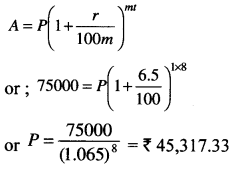
(a) is correct
![]()
Question 9.
The difference between compound interest and simple interest on a certain sum for 2 years @ 10% p.a. is ₹ 10. Find the sum:
(a) ₹ 1,010
(b) ₹ 1,095
(c) ₹ 1,000
(d) ₹ 990
Answer:
(c) Tricks

(c) is correct
Calculator Tricks For 2 years. P = 10 ÷ 10% ÷ 10% button = ₹ 1000.
Question 10.
A machine worth ₹ 4,90,740 is depreciated at 15% on its opening value each year. When its value would reduce to ₹ 2,00,000 : [1 Mark, June 2008]
(a) 5 years 6 months
(b) 5 years 7 months
(c) 5 years 5 months
(d) None
Answer:
(a) is correct
Tricks :-See Type -VI (Quicker BMLRS)
t = \(\frac{\log (2,00,000 / 4,90,740)}{\log (1-15 / 100)}\)
= 5.5 years (approx.)
= 5 yrs. 6 months
Question 11.
If the difference between simple interest and compound interest is ₹ 11 at the rate of 10% for two years, then find the sum: [1 Mark, Dec. 2008]
(a) ₹ 1,200
(b) ₹ 1,100
(c) ₹ 1,000
(d) None of these
Answer:
(b) is correct
Tricks P = \(=\frac{\text { Difference } \times(100)^2}{(\text { rate })^2}\)
= \(\frac{11 \times(100)^2}{(10)^2}\) = ₹ 1100
Calculator Tricks P = 11 + 10% = 10% button = ₹ 1100
Question 12.
In how many years, a sum will become double at 5% p.a. compound interest. [1 Mark, June 2009]
(a) 14.0 years
(b) 14.1 years
(c) 14.2 years
(d) 14.3 years
Answer:
(c) is correct
Tricks t = \(\frac{\log (A / P)}{m e \log (1+r / 100 m)}\)
= \(=\frac{\log (A / P)}{m e \log (1+r / 100 m)}\) = 14.2yrs (approx)
See Quicker BMLRS.
Question 13.
Asum amount to ₹ 1331 at a principal of ₹ 1,000 at 10 % compounded annually. Find the time.
(a) 3.31 years
(b) 4 years
(c) 3 years
(d) 2 years
[1 Mark, June 2009]
Answer:
(c) is correct
Tricks Go by choices
For (c); A = 1000(1 + \(\frac{10}{100}\))3 = ₹ 1331
So; t = 3 yrs.
Calculator Tricks: GBC
(c) A = 1000 + 10% + 10% + 10% button = ₹ 1,331
Question 14.
In how many years, a sum of ₹ 1000 compounded annually @10% will amount to 1331? [1 Mark, Dec. 2009]
(a) 6 years
(b) 5 years
(c) 4 years
(d) 3 years
Answer:
See the above QTS. (13).
Question 15.
The compound interest for a certain sum @ 5% p.a. for first years is ?25. The S-I for the same money @ 5% p.a. for 2 years will be. [1 Mark, Dec. 2009]
(a) ₹ 40
(b) ₹ 50
(c) ₹ 60
(d) ₹ 70
Answer:
(b) is correct Tricks
S.I For 1st yrs. = C. I for 1st yrs. = ₹ 25 S.I
For 2 yrs. For same ‘p’ = 2 × 25 = ₹ 50
Question 16.
At what % rate of compound interest corresponding (C.I) will a sum of money became 16 times in four years, if interest is being calculated compounding annually:
(a) r = 100%
(b) r = 10%
(c) r = 200%
(d) r = 20%
Answer:
(a) is correct
Tricks Go by choices
For (a) Let P = 1; A = 1(1 + \(\frac{100}{100}\))4 = (2)4 = 16
(a) is correct
Question 17.
If the simple interest on a sum of money at 12% p.a. for two years is ₹ 3,600. The compound interest on the same sum for two years at the same rate is: [1 Mark, June 2010]
(a) ₹ 3,816
(b) ₹ 3,806
(c) ₹ 3,861
(d) ₹ 3,860
Answer:
(a) is correct
P = \(\frac{3600 \times 100}{12 \times 2}\) = ₹ 15000
∴ c.i = 15000(1 + \(\frac{12}{100}\))2 – 15000 = ₹ 3816
Tricks:-
CI for 1st yr. = SI for 1st year = 3600 ÷ 2 = ₹ 1800
CI for 2nd year = 1800 + 1800 × 12% = ₹ 2016
C.I for 2 years = 1800 + 2016 = ₹ 3816.
Question 18.
The effective annual rate of interest corresponding to nominal rate 6% p.a. payable half yearly is: [1 Mark, Dec. 2010]
(a) 6.06%
(b) 6.07%
(c) 6.08%
(d) 6.09%
Answer:
(d) is correct
re = [(1 + \(\frac{6}{200}\))2 – 1]
![]()
Question 19.
The cost of Machinery, is ₹ 1,25,000/- If its useful life is estimated to be 20 years and the rate of depreciation of its cost is 10% p.a., then the scrap value of the
Machinery is (given that(o.9)20 = 0.1215)
(a) 15,187
(b) 15,400
(c) 15,300
(d) 15,250
Answer:
(a) is correct
S(Scrap Value) = P\(\left(1-\frac{d}{100}\right)^t\)
where P = Principal;
d = rate of depreciation
∴ S = 1,25,000\(\left(1-\frac{10}{100}\right)^{20}\)
= ₹ 15,187.50
Question 20.
Mr. X invests ‘P’ amount at Simple Interest rate 10% and Mr. Y invests ‘Q’ amount at Compound Interest rate 5% compounded annually. At the end of two years both get the same amount of interest, then the relation between two amounts P and Q is given by:
(a) p = \(\frac{41 Q}{80}\)
(b) p = \(\frac{41 Q}{40}\)
(c) p = \(\frac{41 Q}{100}\)
(d) p = \(\frac{41 Q}{200}\)
Answer:
(a) is correct
S.I = \(\frac{P .10 \times 2}{100}=\frac{P}{5}\)
C.I = Q\(\left[\left(1+\frac{5}{100}\right)^2-1\right]\)
= 0.1025. Q
From Question
S.I = C.I
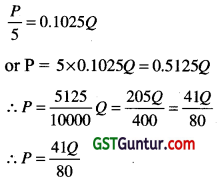
Question 21.
If the difference of S.I and C.I is ₹ 72 at 12% for 2 years. Calculate the amount. [1 Mark, June 2011]
(a) 8,000
(b) 6,000
(c) 5,000
(d) 7,750
Answer:
(c) is correct
Tricks: P = \(\frac{(C . I-S . I) \times(100)^2}{r^2}\)
= \(\frac{72 \times 100 \times 100}{12 \times 12}\) = ₹ 5000
Calculator Tricks:
P = 72 ÷ 12% ÷ 12% = 5000
Question 22.
Nominal rate of interest is 9.9% p.a. If interest is Compounded monthly, What will be the effective rate of interest
(Given \(\left(\frac{4033}{4000}\right)^{12}\) = 1.1036 (approx))? [1 Mark, Dec. 2011, June 2012]
(a) 10.36%
(b) 9.36%
(c) 11.36%
(d) 9.9%
Answer:
(a) is correct.
Tricks:
re = [\(\left(1+\frac{9.9}{1200}\right)^{12}\) – 1] × 100
= 10.36%
Question 23.
The difference between Cl and SI on a certain sum of money for 2 years at 4% per annum is ? 1. The sum is: [1 Mark, June 2013]
(a) 625
(b) 630
(c) 640
(d) 635
Answer:
(a) is correct
Tricks For 2 yrs
Sum of Money = \(\frac{\text { Diff. }(100)^2}{r^2}\)
= \(\frac{1 \times(100)^2}{4^2}\) = ₹ 625
Calculator Tricks:- P = 1 ÷ 4% = 4% button = ₹ 625.
![]()
Question 24.
If the sum of money when compounded annually become 1140 in 2 years and 1710 in 3 years at rate of interest: [1 Mark, June 2013]
(a) 30%
(b) 40%
(c) 50%
(d) 60%
Answer:
(c) is correct.
Interest in 3rd yr. = ₹ 1710 – ₹ 1140 = ₹ 570 ;
Tricks Note For 3rd yr; it will be like S.I ,
r = ∴ \(\frac{1 \times 100}{P t}=\frac{570 \times 100}{1140 \times 1}\) = 50%
Tricks II Go by choices.
For (c) A = 1140 + 50% (Calculator)
= ₹ 1710
∴ (c) is correct
Question 25.
The difference between and C.I & S.I at 7% p.a. for 2 years is ₹ 29.4 then principal is: [1 Mark, Dec. 2013]
(a) ₹ 5,000
(b) ₹ 5,5000
(c) ₹ 6,000
(d) ₹ 6,500
Answer:
(c) is correct
Tricks P = \(=\frac{\text { Difference } \times(100)^2}{r^2}\)
= \(\frac{29.4 \times(100)^2}{(7)^2}\) = ₹ 6000
(See Quicker BMLRS)
Calculator Tricks P = 29.4 ÷ 7% + 1% button = ₹ 6000
Question 26.
The Partners A & B together lent ₹ 3903 at 4% p.a. interest compounded annually. After a spam of 7 years, A gets the same amount as B gets after 9 years. The share of A in the sum of ₹ 3903/- would have been [1 Mark, June 2014]
(a) ₹ 1875
(b) ₹ 2280
(c) ₹ 2028
(d) ₹ 2820
Answer:
(c) is correct
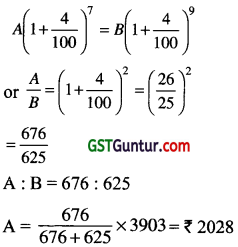
Tricks:- GBC
Question 27.
A certain sum of money double itself in 4 years at C.I. In how many years it will become 32 times to itself: [2014-Dec.]
(a) 15 years
(b) 24 years
(c) 20 years
(d) None
Answer:
(c) is correct
Tricks:- 2t2 – 324
= 2t2 = (25)4 = 220
= t2 = 20
Question 28.
On a certain sum rate of interest @ 10% p.a., S.I= ₹ 90 Term = 2 year, Find Compound interest for the same : [1 Mark, Dec. 2015]
(a) ₹ 544.5
(6) ₹ 94.5
(c) ₹ 450
(d) ₹ 18
Answer:
(b) is correct
S.I ,p.a = \(\frac{90}{2}\) = ₹ 45
Tricks: Compound interest
= 45 + (45 + 10%) = ₹ 94.5
Question 29.
If an amount is kept at simple interest, it earns ₹ 600 in first 2 years but when kept at Compound interest it earns at interest of ₹ 660 for the same period; then the rate of interest and principle amount respectively are: [1 Mark, June 2016]
(a) 20%; ₹ 1200
(b) 10%; ₹ 1200
(c) 20%; ₹ 1500
(d) 10%; ₹ 1500
Answer:
(c)
Tricks:- Go by choices
(c) S.I = \(\frac{1500 \times 2 \times 20}{100}\) = ₹ 600(True)
C.I = 1500[\(\left(1+\frac{20}{100}\right)^2\) – 1] = ₹ 660 (also True)
(c) is correct
Question 30.
Mr. X bought an electronic item for ₹ 1000. What would be the future value of the same item after two years, if the value is compounded semi-annually at the rate of 22% per annum ?
(a) ₹ 1488.40
(b) ₹ 1518.07
(c) ₹ 2008.07
(d) ₹ 2200.00
Answer:
(b) is correct
FV = P (1 + i)n
= ₹ 1518.07 (approx.)
Question 31.
The difference between the simple interest and compound interest on a certain sum of money invested for 2 years at 5% p.a. is ₹ 30. Then the sum = [1 Mark, Dec. 2016]
(a) 10,000
(b) 12,00
(c) 13,000
(d) None
Answer:
(b) Calculator Tricks:
P = 30 ÷ 5% ÷ 5% button = ₹ 12,000
![]()
Question 32.
A sum of money amounts to ₹ 7803 for one year at the rate of 4% compounded semi-annually then the sum invested is: [1 Mark, Dec. 2016]
(a) 7,000
(b) 7,500
(c) 7,750
(d) 8,000
Answer:
(b)
Calculator Tricks:
P = (4 ÷ 200 + 1)÷ = button 2 times × 7803 = button = ₹ 7500
Tricks : (b) (GBC) → A = 7500 + 2% + 2% button = 7803.
Question 33.
The difference between simple and compound interest on a sum of ? 10000 for 4 years at the rate of interest 10% per annum is: [1 Mark, 2017 June]
(a) 650
(b) 640
(c) 641
(d) 600
Answer:
C.I – S.I
= [10,000\(\left(1+\frac{10}{100}\right)^4\) – 10,000] – \(\left[\frac{10,000 \times 10 \times 4}{100}\right]\)
= 4641 – 4000 = ₹ 641
option (c) is correct. [Note: Do by Calculator]
Question 34.
If the compound interest on a sum for two year at the rate 5% p.a. is ₹ 512.50, then the principal is: [1 Mark, Dec. 2017]
(a) 4,000
(b) 3,000
(c) 5,000
(d) None of these
Answer:
(c)
Tricks:- GBC
Amount = 5000 + 5% + 5% button
= 5512.50.
C.I = 5512.50 – 5000 = ₹ 512.50.
Question 35.
Find effective rate of interest corresponding to the nominal rate of interest 7% compounded monthly is : [1 Mark, Dec. 2017]
(a) 7.26%
(b) 7.22%
(c) 7.02%
(d) 7.20%
Answer:
(b)
re = [\(\left(1+\frac{7}{1200}\right)^{12}\) – 1] × 100%
= 7. 229 % = 7.22 %
Question 36.
In compound interest, if the amount is 9 times to its principle in two years then the rate of interest is ? [1 Mark, June 2018]
(a) 300%
(b) 200%
(c) 150%
(d) 100%
Answer:
(b), Given,
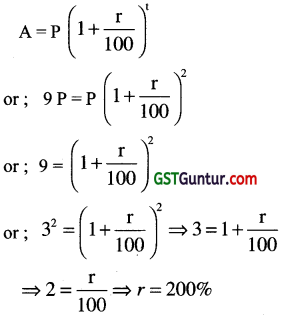
Tricks : – 1 + 200 % + 200 % = 9
So, (b) is correct.
![]()
Question 37.
If difference between Compound Interest and Simple Interest for 3 years is ₹ 912 at the rate 4 % p.a., the principal is: [1 Mark, June 2018]
(a) ₹ 1,87,500
(b) ₹ 1,87,000
(c) ₹ 1,87,550
(d) ₹ 1,85,700
Answer:
(a)
Tricks
P = 912 ÷ 4% ÷ 4% ÷ (300 + 4)%
= ₹ 1,87,500
See QUICKER BMLRS
Question 38.
If Rs. 1,000 be invested at interest at interest rate of 5% and the interest be added to the principal every 10 years, than the number of years in which it will amount to Rs. 2,000 is : [1 Mark, May 2018]
(a) 16\(\frac{2}{3}\) years
(b) 6\(\frac{1}{4}\)
(c) 16 years
(d) 6\(\frac{2}{3}\)
Answer:
(a)
∵ Interest is added to the principal every 10 years. So, within 10 years ; simple interest will apply.
So, Amount after 10 yrs.
= 1000 + 1000 × \(\frac{10 \times 5}{100}\)
= Rs. 1500.
Total amount = Rs. 2000
Extra Interest needed = 2000 – 1500
= Rs. 500.
Time = \(\frac{500 \times 100}{1500 \times 5}=\frac{20}{3}\)
= 6\(\frac{2}{3}\) yrs.
So; Total time = 10 + 6\(\frac{2}{3}\)
= 16\(\frac{2}{3}\) yrs
Question 39.
If an amount is kept at S.I. it earns an interest of Rs. 600 in first two years but when kept at compound interest it earns an interest of Rs. 660 for the same period, then the rate of interest and principal amount respectively are : [1 Mark, May 2018]
(a) 20%., Rs. 1,200
(b) 20%, Rs. 1,500
(c) 10%, Rs. 1,200
(d) 10%., Rs. 1,500
Answer:
(b)
Tricks:- Go by choices (GBC)
(a) S.I = \(\frac{1200 \times 2 \times 20}{100}\) = 480
So; (a) is false.
(b) S.I = \(\frac{1500 \times 2 \times 20}{100}\) = Rs. 600
So; (b) is True.
C.I = (-1500 + 20% + 20%) (button)
= 660
Question 40.
If ₹ 10,000 is invested at 8% per year compound quarterly, then the value of the investment after 2 years is [Given (1+ 0.2)8 = 1.171659]
(a) ₹ 10,716.59
(b) ₹ 11,716.59
(c) ₹ 117.1659
(d) None of these
Answer:
(b)
FV = 100000(1 + \(\frac{8}{400}\))2×4
= ₹ 11716.59
Calculator Tricks: See Quicker BMLRS
Chapter: Compound Interest
Question 41.
A bank pays 10% rate of interest, interest being calculated half yearly. A sum of ₹ 400 is deposited in the bank. The amount at the end of 1 years will be: [1 Mark, Nov. 2018]
(a) ₹ 439
(b) ₹ 440
(c) ₹ 442
(d) ₹ 441
Answer:
(d)
FV = 400\(\left(1+\frac{10}{200}\right)^2\) = 441
Calculator Tricks :
FV = 8000 + 5 % + 5 % + 5 % buttons = ₹ 9261
Question 43.
If in two years time a principal of ₹ 100 amounts to ₹ 121 when the interest at the rate of r % is compounded annually, then the value of r will be
(a) 14
(b) 10.5
(c) 15
(d) 10
Answer:
(d)
Details:
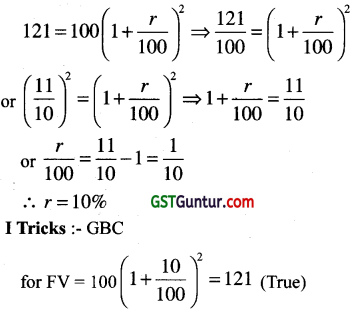
II Calculator Tricks
FV = 100+ 10% + 10% buttons = 121 (True)
![]()
Question 44.
The effective rate of interest for one year deposit corresponding to a nominal 7% rate of interest per annum convertible quarterly is: [1 Mark, Nov. 2018]
(a) 7%
(b) 7.4%
(c) 7.5%
(d) 7.18%
Answer:
(d)
re = [\(\left(1+\frac{7}{400}\right)^4\) – 1] x 100 = 7.18%
Question 45.
How much will ₹ 25,000 amount to in 2 years at compound interest if the rates for the successive years are 4% and 5% per year: [1 Mark, Nov. 2018]
(a) ₹ 27,000
(b) ₹ 27,300
(c) ₹ 27,500
(d) ₹ 27,900
Answer:
(b)
FV = 25000\(\left(1+\frac{4}{100}\right) \times\left(1+\frac{5}{100}\right)\)
= ₹ 27,300/-
Calculator Tricks:- 25000 + 4% + 5% buttons
= ₹ 27,300/-
Question 46.
₹ 8,000/- at 10% per annum interest compounded half yearly will become at the end of one year: [1 Mark, Nov. 2018]
(a) ₹ 8,800
(b) ₹ 8,900
(c) ₹ 8820
(d) ₹ 9,600
Answer:
(c)
FV = 8000\(\left(1+\frac{10}{200}\right)^2\) = ₹ 8,820
Calculator Tricks
FV = 8000 + 5 % + 5% buttons = 8820
Question 47.
The value of furniture depreciates by 10% a year, if the present value of the furniture in an office is ₹ 21870, calculate the value of furniture 3 years ago: [1 Mark, Nov. 2018]
(a) ₹ 30,000
(b) ₹ 40,000
(c) ₹ 35,000
(d) ₹ 50,000
Answer:
(a)
Calculator TricksGBC
(a) 30000 – 10% – 10% – 10% button = 21870.
Details Method
21870 = P\(\left(1+\frac{10}{100}\right)^3\)
P = \(\frac{21870}{(0.9)^3}\) = ₹ 30,000
Question 48.
If compound interest on a sum for 2 years at 4% per annum is ₹ 102, then the simple interest on the same period at the same rate will be: [1 Mark, Nov. 2018]
(a) ₹ 90
(b) ₹ 100
(c) ₹ 101
(d) ₹ 93
Answer:
(b)
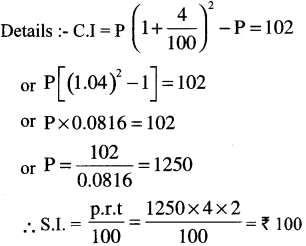
Tricks Go by choices
For option (b)
S.I. for 2 years = ₹ 100
S.I. for 1 years = ₹ 50
S.I. of 1st yr. = C.I. of 1st yr. = ₹ 50
C.I. for 2nd yr. = 50 + 4% = ₹ 52
Total C.I. for 2 yrs = 50 + 52 = ₹ 102 (True)
Option (b) is correct
Question 49.
If the difference between the compound interest compounded annually and simple interest on a certain amount at 10% per annum for two years is ₹ 372, then the principal amount is: [1 Mark, Nov. 2018]
(a) ₹ 37,000
(b) ₹ 37,200
(c) ₹ 37,500
(d) None of the above
Answer:
(b)
Tricks
P = 372 + 10% ÷ 10% = ₹ 37,200
Question 50.
What is the net present value of piece of property which would be valued at ₹ 2 lakh at the end of 2 years? (Annual rate of increase = 5%): [1 Mark, Nov. 2018]
(a) ₹ 2.00 lakh
(b) ₹ 1.81 lakh
(c) 2.01 lakh
(d) None of the above
Answer:
(b)
NPV = 2\(\left(1+\frac{5}{100}\right)^{-2}\) = 1.81 lakh (approx)
![]()
Question 51.
A sum was invested for 3 years as per C.I. and the rate of interest for first year is 9%, 2nd year is 6% and 3rd year is 3% p.a. respectively. Find the sum if the amount in three years is Rs. 550 ? [1 Mark, June 2019]
(a) Rs. 250
(b) Rs. 300
(c). Rs. 462.16
(d) Rs. 350
Answer:
Question 52.
The effective rate of interest does not depend upon
(a) Amount of Principal
(b) Amount of Interest
(c) Number of Conversion Periods
(d) None of these
Answer:
(a) is correct
Question 53.
If p. i2 = 96, and R = 8% compounded annually then P =
(a) Rs. 14,000
(b) Rs. 15,000
(c) Rs. 16,000
(d) Rs. 17,000
Answer:
(b)
Tricks Given , p. i2 = 96
Means interest of two periods (yrs. here) is 96.
So; GBC (Calculator Tricks)
(a) I = 14000 × 8% × 8%
= 89.6 ≠ 96
So; (a) is False.
(b) Type 15000×8% × 8% button
We get 96.
So; (b) is correct.
Tricks II
P = 968% ÷ 8% buttons.
= Rs. 15,000.